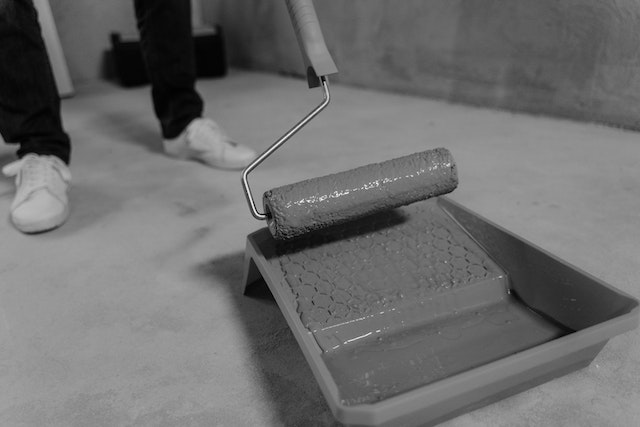Have you faced the dilemma of wanting to renew or change the color of your walls but not having the exact paint type?
Maybe you recently moved into an oil-painted house, but you prefer latex paint. Now, the question lingering on your mind is, “Can you paint latex over oil based paint?”
In this blog post, we’ll help you solve the puzzle of whether you can put latex paint over oil-based paint. We’ll explore what happens if you mix the two paint types and what you can do to achieve a desirable outcome with your painting project.
Can You Paint Latex Over Oil Based Paint?
Yes, you can paint latex paint over oil-based paint. You need to clean the surface with oil-based paint, sand and apply a high-quality primer before applying latex paint. Otherwise, your latex paint won’t adhere properly.
Can you apply oil-based paint over latex paint?
Painting oil-based paint over latex paint is much easier and works better than painting latex paint over oil-based paint. This is because when latex paint dries, the water in it evaporates, making it easier for oil paint to stick to the surface.
However, it’s generally not recommended since latex paint is more flexible and breathable, while oil paint is rigid and less porous. For the best results, it’s advisable to remove the latex paint or prime it with a suitable bonding primer before applying oil-based paint. Proper surface preparation is also essential to achieve a durable and long-lasting finish.
Why painting latex directly over oil-based paint is a mistake
Are you wondering why you can’t just put your latex paint directly over the existing oil-based paint?
That’s because it’s a recipe for disaster!
Latex and oil paint have significant differences in composition and characteristics – mixing them directly won’t work.
Here are a few reasons why it’s generally not recommended:
Adhesion issues: The smooth and glossy surface of oil-based paint creates a poor bonding surface for water-based paint. This leads to poor adhesion and potential paint failure.
Incompatibility of solvents: Oil paints contain solvents that can cause the latex paint to soften or dissolve upon contact. This can result in bubbling, wrinkling, or a textured appearance on the painted surface.
Expansion and contraction rates: Latex and oil-based paints expand and contract differently due to temperature and humidity changes.
This disparity can lead to cracking, peeling, or other forms of paint failure when you apply latex over oil-based paint. Note that this does not apply to using latex paint on oil-based primers as these primers are compatible with any type of paints.
How to Tell if Latex is Applied Over Oil Paint
When the surface is prepared properly, latex and oil paint can mix so well that it’s hard to tell.
So, how can you tell that a surface was painted with latex over an existing oil-based paint? Here are a few techniques to use:
1. Perform a cross-hatch test
Scratch an inconspicuous area of the surface with a sharp knife or razor blade in a cross-hatch pattern and cover it with a piece of adhesive tape.
Quickly peel the tape off and see whether the paint comes off in small flakes and reveals multiple layers. If so, it indicates that latex paint was applied over oil-based paint.
2. Check for cracking or peeling
Over time, latex paint applied over oil-based paint can develop cracks or start peeling.
Check for any areas where the paint is visibly cracking or peeling, as it could suggest the use of latex paint over an oil-based layer.
3. Observe the sheen and texture
Oil-based paint typically has a higher sheen and a smoother, more glossy appearance than latex paint.
If the painted surface has a slightly textured finish, it may indicate the presence of a latex paint layer.
How to Paint (latex) Over Oil-Based Paint
Now that you know the necessary precautions, let’s take you through a step-by-step guide on how to give your oil-painted surfaces a new glamorous look using latex paint:
What you’ll need (Tools and materials).
- Latex paint.
- Bonding primer.
- Paintbrushes/rollers.
- Drop cloth.
- Fine-grit sandpaper.
- Putty knife/paint scrapper.
- Tack cloth/damp cloth.
- Paint tray.
- Painter’s tape.
- Wood filler.
- Clean soapy water.
Procedure
1.Prepare your working area
To avoid staining, prepare your working area by removing furniture and covering the floor with a drop cloth.
You can also use painter’s tape to cover trim, baseboards, and other areas you don’t want the paint to reach.
2. Scrap-off paint peels
Using a putty knife or a paint scrapper, scrap off any visibly peeling paints that may hinder adhesion and make the surface look rugged.
The paint should peel off easily with less effort.
3. Clean the surface
Use a soft cloth and soapy water to clean the surface to remove dirt, debris, grease, and other extraneous substances.
Let it dry completely after cleaning.
4. Sand the surface
After cleaning, lightly sand the oil-painted surface using fine-grit sandpaper to roughen the surface slightly for the new paint to adhere.
Sanding will also reduce the gloss or smoothness of the oil paint film. After sanding, wipe away any dust using a tack cloth or a damp cloth.
5. Apply bonding primer
Now that you’re ready to paint, start by applying a thin coat of latex primer (specifically formulated for transitioning from oil-based to latex paint).
Apply the primer in small sections, giving it enough time to dry completely.
6. Apply latex paint
Once the bonding primer is dry, you can proceed with applying latex paint. Stir the paint thoroughly to ensure proper consistency.
Apply the latex paint in even coats using a paintbrush or roller. Working in small sections as you did with the primer.
Apply additional coats as necessary, allowing sufficient drying time between each coat.
7. Clean up
Once you’ve finished the painting work, it’s time to do some clean-up. Clean your brushes, rollers, and other tools with soap and water immediately after use.
Since latex is a water-based paint, you don’t need any solvents or strong detergents to do the cleaning.
Follow proper disposal guidelines for any leftover paint or paint-related materials.

Can you paint latex over oil paint without sanding?
While you can choose to paint latex over oil-based paint without sanding, it will not produce the best outcome.
This is because oil paint often produces a smooth and glossy finish, which does not support proper adhesion. When you sand the surface, it reduces the smoothness and gives the latex paint a relatively rough surface to adhere to.
However, you can skip the sanding stage if you have a high-quality bonding primer that supports proper adhesion.
Beware that failing to sand the surface may still affect the long-term durability of the oil paint.
Will latex paint last long on oil-based paint?
When the surface is well prepared and the paint applied properly, latex paint can last considerably long on oil-painted surfaces. For it to last longer, you also need to use high-quality latex paint and bonding primer. Additionally, ensure you limit factors that reduce longevity, like moisture, excessive scrubbing, and exposure to harsh chemicals.
Latex paint over oil-based paint: How to fix the error
Have you mistakenly applied latex paint over oil paint and wondering what to do next? Maybe you’ve noticed the paint feeling chalky or chipping off at the slightest scratch.
If you find yourself in this situation, follow these steps to fix the error:
1. Remove the top latex paint: Use warm water, a mild detergent, and a scouring pad to remove the latex paint.
You can also use a paint scrapper to remove layers of peeling paint. Alternatively, you can apply a latex paint stripper to help you strip off the paint effortlessly.
Once the paint comes off, rinse the previously painted surface with clean water and allow it to dry completely.
2. Sand the surface: Now that you’ve removed the latex paint, you can prepare the surface properly to apply a fresh coat of latex paint (the right way)
Use fine-grit sandpaper to lightly sand the surface to improve adhesion. This will allow the new paint to adhere well.
3. Prime the surface: Using a paintbrush or a roller, apply one coat of extreme bonding paint primer evenly over the surface and let it dry completely.
4. Apply top coat: Once the primer has dried completely, you can apply a topcoat of latex paint.
Choose a high-quality latex paint suitable for your project and apply it using a paintbrush or roller. Apply two coats, allowing enough drying time between the coats.
5. Evaluate the results: Let the new paint dry completely, then assess the finish. If you are satisfied with the results, you have successfully fixed the error of applying latex paint over oil-based paint.
FAQs – Painting Latex Over Oil-based Paint
What happens if you paint latex over oil paint?
If you apply latex directly over oil-based paint, it may not adhere well. This may lead to peeling or cracking over time. For the paint to adhere well, you need to follow the recommended practices to prepare the surface appropriately.
How do you get latex paint to stick to oil-based paint?
For latex paint to adhere to oil-based paint, you need to prepare the surface well. You can do this by cleaning the surface, lightly sanding to create a roughened texture, and applying a bonding primer designed for transitioning from oil-based to latex paint.
Will latex paint stick to oil-based primer?
Yes, latex paint can generally stick to oil-based prime, provided the primer has fully cured, and the surface is properly prepared. However, it’s important to follow manufacturer guidelines and ensure the bonding primer is compatible with the latex paint you intend to use.
Does oil-based paint dry faster than latex?
Oil-based paint typically takes longer to dry than latex paint. It can take up to 24 hours or longer to dry completely. On the other hand, latex paint dries within 1 to 2 hours after applying. Factors like temperature, humidity, and thickness of the paint coat applied can also affect drying time.
Is there a latex paint that can go over oil-based paint?
Yes, there are latex paints specifically designed for applying directly over oil-based paint with minimal surface preparation. These paints are designed to promote good adhesion to oil-painted surfaces. It’s essential to carefully follow the instructions provided by the manufacturer for best results.
Content Summary – Latex over oil-based paint
In conclusion, applying latex paint over oil-based paint is generally not a recommended practice. Latex paint naturally doesn’t adhere well to the smooth and glossy finish of oil paints.
However, with proper preparation, like sanding the surface and applying a high-quality primer, you can achieve a long-lasting and aesthetically pleasing paint job.
If you find yourself in a situation where you’ve mistakenly applied latex paint over oil-based paint, follow the steps outlined in this article to salvage the situation.
Remember to seek professional advice if you are uncertain about the compatibility of the paint layers.
Happy painting!

